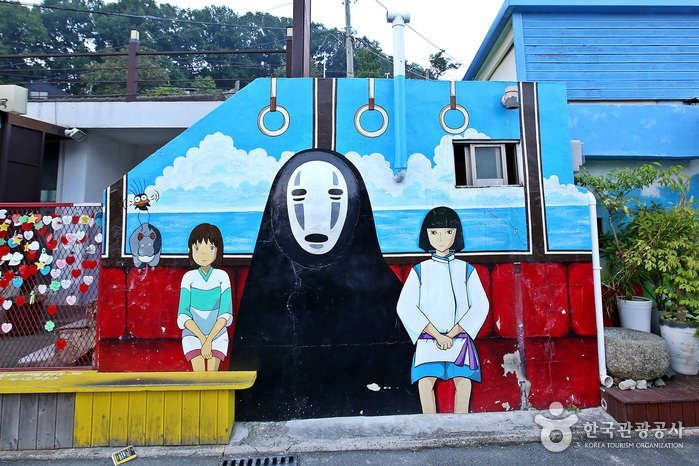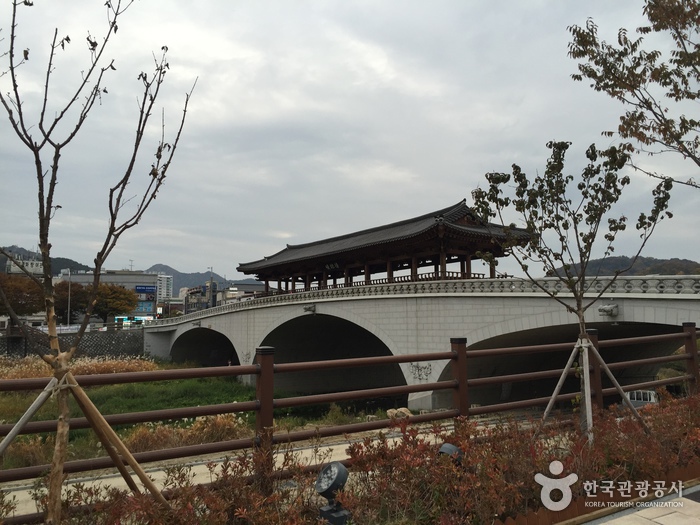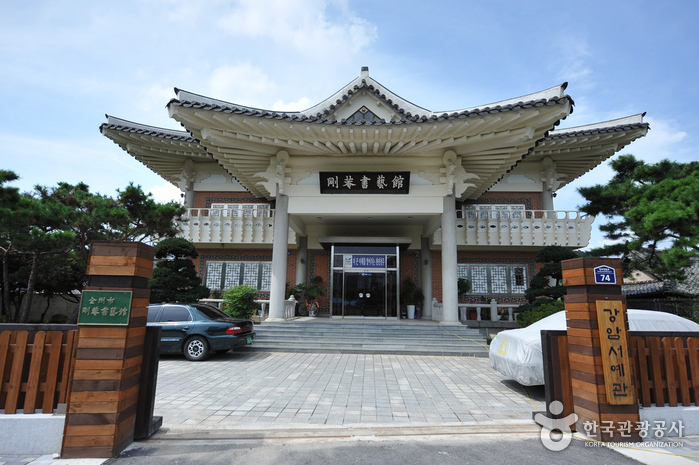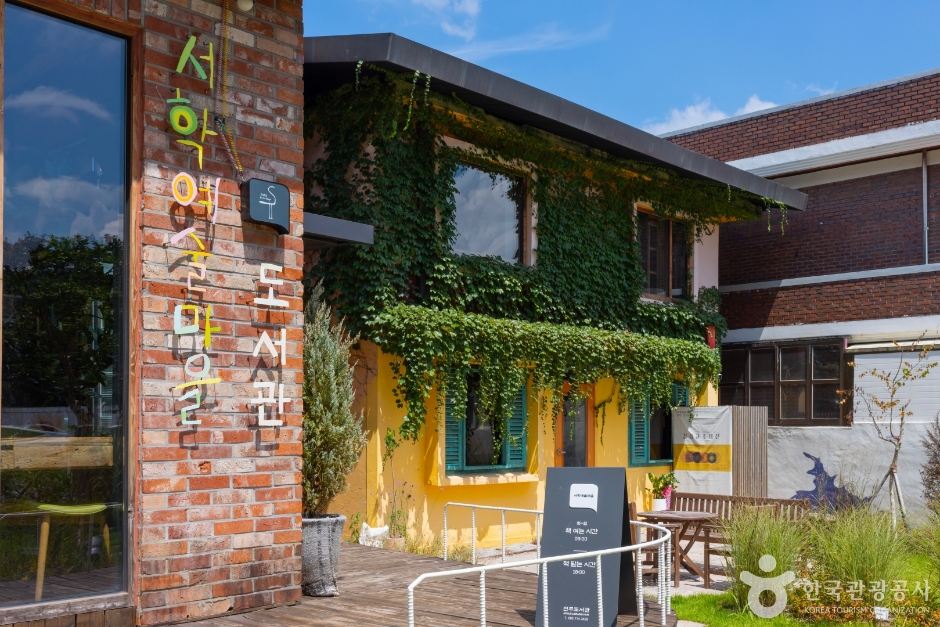Túnel Hanbyeok (한벽터널)
2.1Km 2024-04-06
Gyo-dong San 7-3, Wansan-gu, Jeonju-si, Jeonbuk-do
Escuela Confuciana Jeonju Hyanggyo (전주향교)
2.3Km 2025-07-09
Hyanggyo-gil 139, Wansan-gu, Jeonju-si, Jeonbuk-do.
Es una escuela confuciana que fue fundada en la dinastía de Joseon (1392-1910) y fue designada como Tesoro Histórico. Fue un establecimiento educativo del período de Joseon que estuvo originariamente ubicado en el sitio del santuario Gyeonggijeon, pero fue relocalizado en este lugar en 1603. Las tablillas mortuorias de 7 eruditos confucianos chinos y los 18 eruditos coreanos están conservadas en el edificio principal llamado Daeseongjeon.
Galería de Murales de la Aldea Jaman (자만마을 벽화갤러리)
2.5Km 2025-07-10
Gyo-dong, Wansan-gu, Jeonju-si, Jeonbuk-do
2521 (이오이일)
2.5Km 2025-07-17
5-19, Omokdae-gil, Wansan-gu, Jeonju-si, Jeonbuk-do
Pabellón Cheongyeonru del Puente Namcheongyo (남천교 청연루)
2.6Km 2024-04-06
Cheongyeong-ro 40, Wansan-gu, Jeonju-si, Jeonbuk-do
El puente Namcheongyo es el puente principal que conduce a la Aldea Tradicional de Gyo-dong de Jeonju desde el barrio de Seohak-dong de la ciudad de Jeonju. A través de un importante proyecto de regeneración urbana, toda el área del puente Namcheongyo tuvo una renovación que mejoró la infraestructura disponible, agregando incluso el pabellón Cheongyeonru al puente. Los visitantes pueden disfrutar de una vista panorámica de la zona desde este pabellón de estilo tradicional hanok y al mismo tiempo refugiarse del sol en un día caluroso.
Museo de Caligrafía Gangam (강암서예관)
2.6Km 2024-04-07
Jeonjucheondong-ro 74, Wansan-gu, Jeonju-si, Jeonbuk-do.
Jeonju es considerada como una de las ciudades de la cultura y el arte de Corea, pero si desea sentir su ambiente artístico más de cerca y profundamente, visite el museo de caligrafía Gangam, situado en los alrededores de la Aldea Tradicional. El museo fue inaugurado en el año 1995 y es visitado por una gran cantidad de personas que aman el arte. En sus cercanías se encuentran varios lugares turísticos, considerados como valiosos patrimonios del país, la puerta Pungnammun, el santuario Gyeonggijeon, y hacia el este, la Escuela Confuciana Jeonju Hyanggyo, junto con el monte Omokdae, etc.
Este museo fue fundado en conmemoración y homenaje al gran maestro Song Seong-yong, cuyo seudónimo era “Gangam”, quien fue un famoso calígrafo nacido en esta región. Siendo el único museo exclusivo de la caligrafía en el país, expone un total de 1.162 piezas artísticas de las siguientes figuras claves del ramo: Chusa Kim Jeong-hui, funcionario público y calígrafo de Joseon, Lee Sam-man (seudónimo Changam), Kim Hong-do (seudónimo Danwon), Jeong Yak-yong (seudónimo Dasan), famoso filósofo religioso de Joseon, etc.
Por otro lado, a 200 m de distancia de este museo se inauguró la Sala Conmemorativa de la Revolución Donghak, por lo tanto, también podrá aprovechar la ocasión para conocer la historia de esta revuelta campesina.
Bu Yong Heon (부용헌)
2.7Km 2025-06-17
149-3, Hyanggyo-gil, Wansan-gu, Jeonju-si, Jeonbuk-do
Buyongheon is located in Jeonju Hanok Village. Precisely speaking, Buyongheon is the very next door to Jeonju Hyanggyo (Confucian Temple and School). Across the alley are Jeonju Hyanggyo Culture Center and Wanpanbon Culture Center. If you walk a few more steps, you will reach Jeonju Hanbyeok Culture Center where you can see various performances and experience the culture and foods of Jeonju. Omokdae can be seen from the garden of Buyongheon. Across the Jeonjucheon Stream is the National Intangible Heritage Center.
The beginning of Buyongheon is deeply related with Jeonju Hyanggyo. In around 1935, the local bureaucrats lived around the Hyanggyo after building 12 houses one after another. Most of them came from rich families. These collective houses were called Buyong Houses, which meant rich houses. The name Buyongheon originated from Buyong Houses. The rooms of Buyongheon are composed of Toenmaru Bang, Daecheong Maru Bang, Large Daecheong Maru Bang and Big Sarangchae. The interior of the rooms looks neat with the beauty of blank space as they excluded unnecessary decorations. Carefully prepared breakfast is served upon request made in advance. Visitors can also experience traditional culture such as traditional etiquette education and Korean paper art.
In fall, the yellow leaves of the ginkgo tree in the garden of Jeonju Hyanggyo lights up the roof of Buyongheon. It is recommendable to walk along the Jeonjucheon Stream and take pictures of the colorful murals and the cafes in the Jaman Mural Village located on the left sie of the Hanok Village. It takes 15 minutes from Jeonju Station and 10 minutes from Jeonjuu Express Bus Terminal to Buyongheon by taxi.
Omokdae e Imokdae (오목대와 이목대)
2.7Km 2025-07-10
Girin-daero 55, Wansan-gu, Jeonju-si, Jeonbuk-do.
Omokdae está situado en la cima de una colina y se trata de uno de los lugares donde Yi Seong-gye (quien se convirtiera más tarde en el rey Taejo, el primero de la dinastía Joseon) hizo una parada para celebrar su victoria de camino a casa tras la guerra contra los invasores japoneses, al final de la era Goryeo. Enfrente de Omokdae está Imokdae, situado cerca de los pies del monte Seungamsan, donde se encuentra Chimyeongjasan, un monumento católico. En este lugar, Mokjo (antepasado del rey Taejo) solía jugar con sus amigos a representar guerras de niño, una acción muy simple que aparecería después en 'Yongbieocheonga', una balada del siglo XV que narra los logros culturales de la nación.
Hanok Garden in Jeonju (전주한옥마당)
2.7Km 2025-10-23
80-13, Jeonjucheondong-ro, Wansan-gu, Jeonju-si, Jeonbuk-do
Jeonju Hanok Madang is located in the Jeonju Hanok Village. Jeonjucheon Stream and Namcheongyo Bridge are only one block away, whereas Gangam Calligraphy Museum, Jeonjuhyangyo Confucian School, Jeonju Hanbyuk Culture Center, Nambu Market, and Markbu Market Youth Mall are nearby. Major attractions of the Jeonju Hanok Village such as Gyeonggijeon, Jeondong Catholic Cathdral, and Omokdae are also within walking distance.
The main building and servants’ quarters of Jeonju Hanok Madang were built in 1941. It was renovated to retain the original shape of the traditional hanok, yet cozy and comfortable enough for modern people to use. Porches are attached to every room while Faith Room and Hope Room have additional inner floors attached to it. Inside the rooms are rafters, beams, wooden pillars walled with Hanji wallpapers, and ribs of lattice doors. There is a clean bathroom in each room.
The yard is the place the owner couple cherishes the most. Guests can enjoy the yard in any room just by opening the door. It is a combination of jar stands, a small pine tree, and small potted plants. Different flowers bloom from spring through autumn. It is such a pleasure to sit on the porch and appreciate the scene. In autumn, the persimmon tree bears fruits and dried persimmons hang from the eaves.
Biblioteca de la Aldea Artística Seohak (서학예술마을도서관)
2.7Km 2024-10-15
Seohak-ro 12-1, Wansan-gu, Jeonju-si, Jeonbuk-do










 Español
Español
 한국어
한국어 English
English 日本語
日本語 中文(简体)
中文(简体) Deutsch
Deutsch Français
Français Русский
Русский